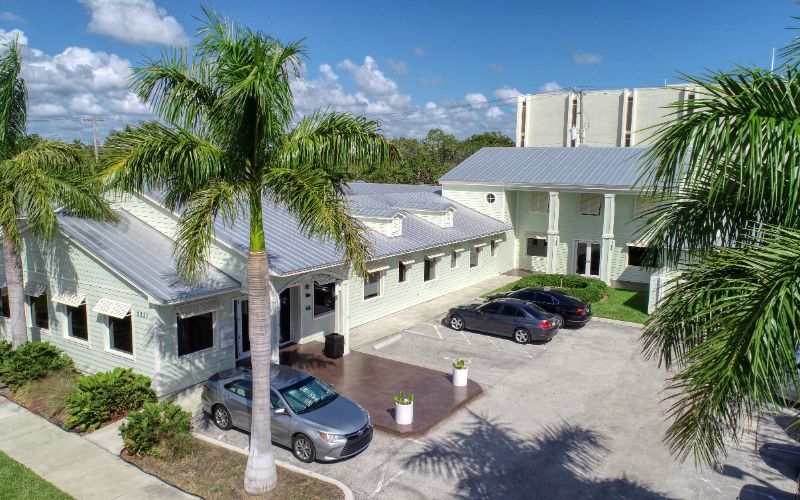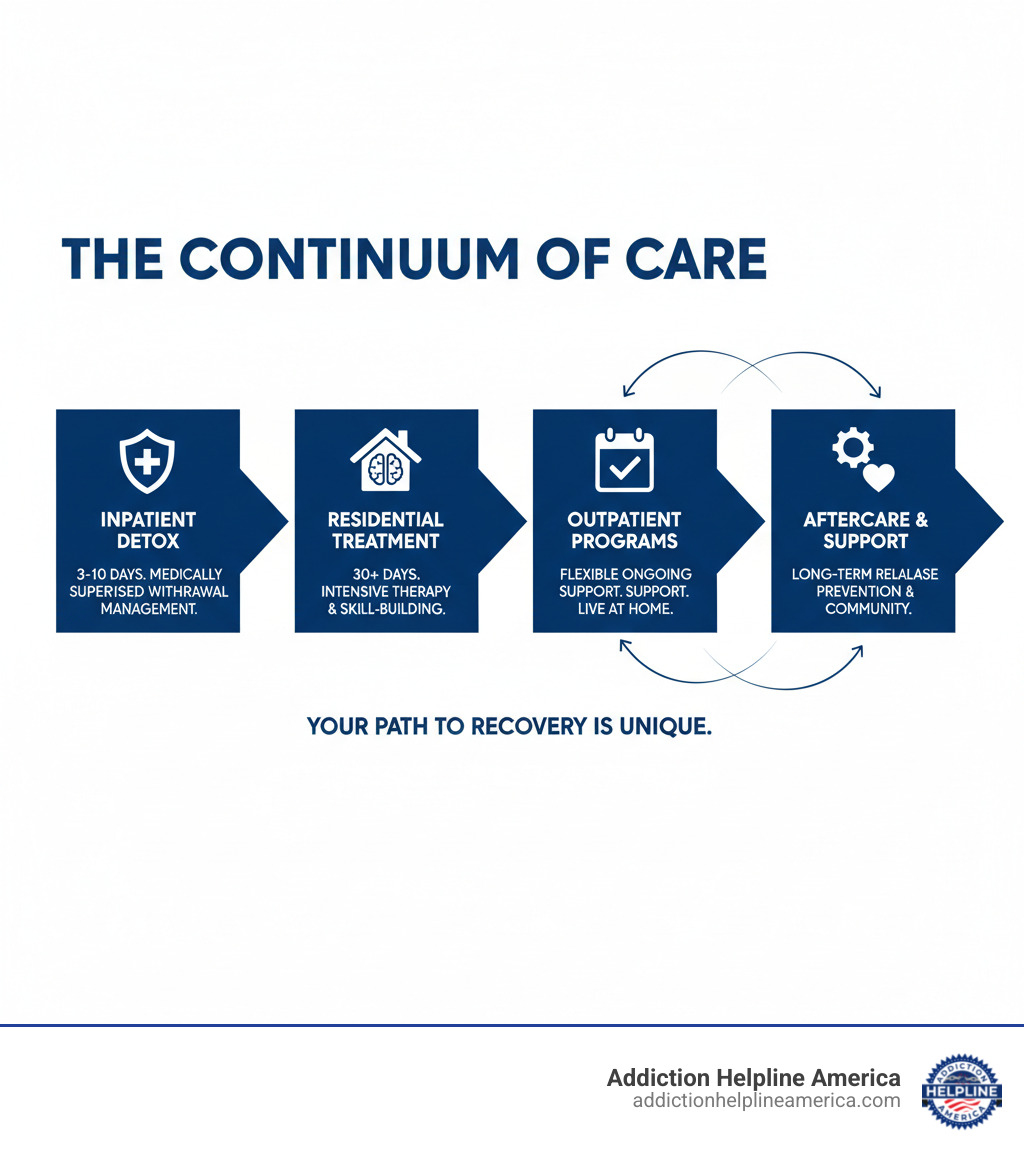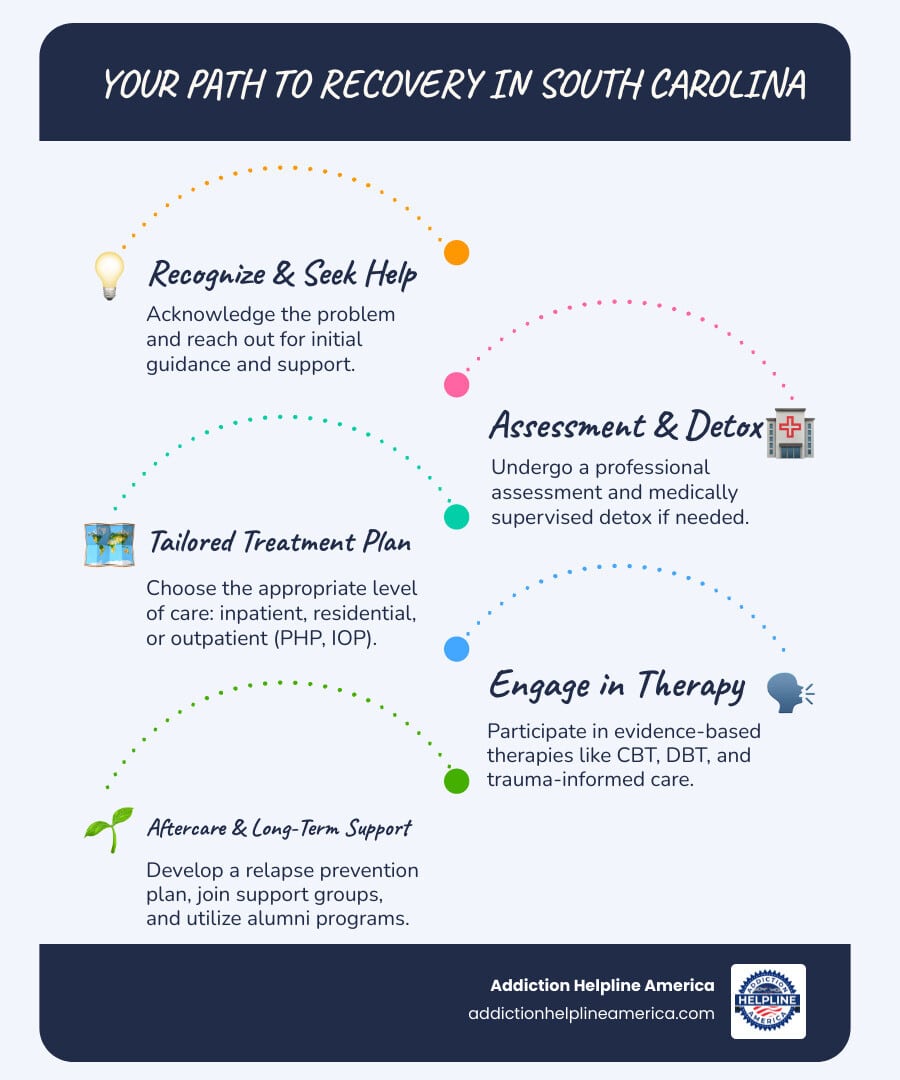
Understanding Your Path to Recovery: What You Need to Know About Inpatient Detox
Inpatient detox facilities near me offer medically supervised withdrawal management in a residential setting where you stay 24/7 during the critical first days of recovery. Here’s a quick overview:
Quick Answer: Finding Inpatient Detox Near You
- What it is: A safe, structured environment with 24/7 medical monitoring as your body clears addictive substances.
- How long: Typically 3-10 days, based on the substance and individual needs.
- What’s included: Medical evaluation, medication for withdrawal symptoms, emotional support, and planning for next steps.
- How to find: Use online directories like FindTreatment.gov, contact your state health agency, or call a helpline for immediate help.
- Cost: Most insurance plans (Medicaid, Medicare, private) cover detox. Sliding-scale fees or payment plans are often available.
When you’re struggling with addiction, the thought of withdrawal can be terrifying, but inpatient detox provides the medical care and support to make this first step safe and manageable. For substances like alcohol, opioids, and benzodiazepines, attempting to detox without medical supervision can be life-threatening. A medically supervised program provides medication to ease symptoms, constant monitoring, and immediate intervention if complications arise.
However, detox is just the beginning. The real work of addressing the root causes of addiction happens in the treatment that follows, such as residential rehab or outpatient programs.
At Addiction Helpline America, we connect individuals and families with appropriate inpatient detox facilities near me and comprehensive treatment resources. Finding the right facility can feel overwhelming, which is why our specialists provide 24/7 support to guide you. This article answers common questions about inpatient detox to help you take that critical first step.
Inpatient detox facilities near me glossary:
1. What is Inpatient Detox and Why is it a Critical First Step?
Inpatient detox means you stay at a treatment facility around the clock while medical professionals help your body safely clear addictive substances. It is the first step in recovery because attempting to stop using certain substances can cause withdrawal symptoms that are not only uncomfortable but also dangerous.
24/7 medical supervision is critical. Doctors and nurses monitor your vital signs, manage complications, and administer medications to ease symptoms and cravings. This is especially important for alcohol and benzodiazepine withdrawal, which can cause life-threatening seizures. Inpatient detox provides a controlled, substance-free environment, removing you from triggers and temptations so you can focus on physical stabilization.
Detox alone isn’t recovery. It’s the essential foundation that gets the substances out of your system. The deeper work of understanding addiction and developing coping skills happens in the treatment that follows. You can learn more about the full spectrum of care in our guide to addiction treatment.
What Are the Benefits of Choosing an Inpatient Detox Facility Near Me?
For many, an inpatient detox facility offers benefits that can’t be replicated at home. The primary benefit is safety from severe withdrawal symptoms. For substances like alcohol, opioids, and benzodiazepines, withdrawal can be a medical emergency. In an inpatient setting, medical staff can provide immediate intervention.
Other key benefits include a controlled, substance-free environment that prevents relapse during this vulnerable time and immediate medical intervention with medications to reduce discomfort. You also receive peer and professional emotional support from counselors and others going through similar struggles, which combats the isolation of addiction.
Here’s how the features of inpatient detox translate into real benefits:
| Feature | Inpatient Detox Benefit |
|---|---|
| 24/7 Medical Care | Constant monitoring to manage dangerous symptoms like seizures or dehydration. |
| Controlled Environment | Complete separation from substances and triggers, preventing relapse. |
| Medication Management | Medications to ease symptoms and cravings, making withdrawal safer and more tolerable. |
| Emotional Support | Counselors and peers help reduce anxiety and prepare you for the next steps. |
| Peer Community | Connection with others creates motivation, hope, and a sense of belonging. |
| Structured Routine | A predictable schedule provides stability and reduces anxiety. |
| Foundation for Rehab | Physical and emotional stabilization improves your chances of long-term success in subsequent treatment. |
Choosing a facility near you also makes it easier for family to visit and creates continuity of care as you transition to local outpatient services. Starting with a medically supervised detox gives you the best possible advantage. To better understand how this fits into the broader continuum of care, check out our breakdown of types of treatment programs.
2. What Happens During Inpatient Detox?
Understanding the process of inpatient detox can ease anxiety. The journey is structured to keep you safe and comfortable. It generally involves three main stages:
- Evaluation and Assessment: Upon arrival, a medical team conducts a comprehensive assessment of your medical history, substance use patterns, and any co-occurring mental health conditions. This forms the basis of your personalized detox plan.
- Stabilization: This is the core of detox, where you receive 24/7 medical monitoring. Staff manage your withdrawal symptoms, often using FDA-approved medications to reduce discomfort and prevent dangerous complications. This process is known as medically-assisted treatment (MAT).
- Treatment Planning: As you stabilize, the team helps you plan for the next steps in recovery. This includes preliminary counseling and education to prepare you for ongoing treatment, as detox is only the first step.
A structured daily routine of meals, medication, and rest provides comfort and predictability. For more context on why certain substances are so hard to quit, see our guide on the most addictive drugs.
What Substances and Withdrawal Symptoms Are Managed?
Inpatient detox facilities near me are equipped to manage withdrawal from a range of substances, each with unique risks.
- Alcohol: Withdrawal can be life-threatening, with risks of seizures and delirium tremens (DTs). Medical teams use medications to calm the nervous system and prevent these complications.
- Opioids (Heroin, Fentanyl, Painkillers): Withdrawal is uncomfortable, with severe flu-like symptoms. Medically-assisted treatment (MAT) with medications like Buprenorphine (Suboxone) or Methadone makes the process manageable. Learn more about Suboxone withdrawal symptoms.
- Benzodiazepines (Xanax, Valium): Abruptly stopping can cause seizures and psychosis. A slow, medically supervised taper is required for safety.
- Stimulants (Cocaine, Meth): Withdrawal is primarily psychological, involving severe depression, fatigue, and intense cravings. Treatment focuses on supportive care.
Symptoms can be both physical (nausea, tremors, aches) and psychological (anxiety, depression, insomnia). MAT is the standard of care, combining medication with counseling to treat the whole person and improve long-term outcomes.
How Long Does Inpatient Detox Last?
Inpatient detox typically lasts between 3 and 10 days, but the exact duration depends on several factors:
- Substance Type and History: Longer, heavier use or withdrawal from certain substances like benzodiazepines may require a longer stay.
- Co-occurring Disorders: Managing mental health conditions like depression or anxiety alongside withdrawal takes extra time. Our bipolar depression treatment guide 2025 explains this link.
- Individual Health: Your age, physical health, and metabolism affect how quickly your body processes substances.
- Multiple Substances: Detoxing from more than one substance is more complex and often extends the timeline.
The goal is not speed, but safety. You will transition to the next level of care only when you are medically stable.
3. How to Find and Pay for Inpatient Detox Facilities Near Me
Finding the right inpatient detox facilities near me during a crisis can be stressful. Here’s a straightforward guide to finding and paying for care.
How Can I Find Reputable Inpatient Detox Facilities Near Me?
Finding a quality facility is key. Here are several reliable methods:
- Use a Helpline Service: At Addiction Helpline America, we offer free, confidential guidance. Our team vets facilities and can connect you to a trusted center that fits your needs and insurance.
- Consult Online Directories: The Substance Abuse and Mental Health Services Administration (SAMHSA) offers a searchable national directory at FindTreatment.gov.
- Check State Resources: Your state’s health department website lists licensed and often state-funded treatment centers.
- Ask Your Doctor: Your primary care physician can provide referrals to reputable local facilities.
- Verify Accreditation: Look for accreditation from organizations like The Joint Commission (JCAHO) or the Commission on Accreditation of Rehabilitation Facilities (CARF). This is a strong indicator of quality and safety.
For a comprehensive look at options, explore our drug rehab near you page.
How Does Insurance and Payment Work?
Let’s break down the cost. Treatment is more accessible than many people think.
- Insurance Coverage: The Affordable Care Act (ACA) made substance use disorder treatment an essential health benefit. This means most Marketplace, private, and small group plans must cover detox services.
- Medicaid and Medicare: These government programs often cover a substantial portion of treatment costs, especially in states that expanded Medicaid.
- Private Insurance: Most employer-sponsored or private plans cover detox, but deductibles and co-pays vary. Always verify your benefits with the insurance provider or the facility’s admissions team before starting treatment.
- Options Without Insurance: If you don’t have insurance, ask facilities about sliding scale fees (based on income), payment plans, or financing options. Some non-profits also offer low-cost or free services.
Navigating payment can be complex, but you don’t have to do it alone. We can help you understand your options. For more guidance, visit our insurance page.
4. What Happens After Detox?
Detox is only the beginning of your recovery journey. While it clears your body of substances, it doesn’t address the underlying psychological and behavioral aspects of addiction. For lasting recovery, it is critical to transition to a comprehensive treatment program.
Research shows that individuals who continue with treatment after detox have significantly better outcomes. This next phase focuses on relapse prevention planning, where you learn to identify triggers and develop healthy coping skills. It also involves building a support system of peers, family, and professionals. Recovery is a process of continuing care, much like managing any other chronic condition. For more insights, you can explore our information on addiction treatment success rates.
What Are the Next Steps in the Recovery Process?
After detox, your treatment team will recommend the next appropriate level of care based on your needs. Common options include:
- Residential Inpatient Rehab: You live at the facility for 30 days or more, engaging in intensive individual and group therapy in a structured, supportive environment.
- Partial Hospitalization Program (PHP): The most intensive outpatient care, involving treatment at a facility for several hours a day, 5-6 days a week, while living at home or in a sober living residence.
- Intensive Outpatient Program (IOP): A more flexible option with 9-15 hours of therapy per week, allowing you to maintain work or school commitments.
- Sober Living Homes: Structured, substance-free residences that provide peer support and accountability as you transition back to independent life.
- Therapy and Counseling: Ongoing individual or group therapy is central to recovery. Evidence-based approaches like Cognitive Behavioral Therapy (CBT) help you change negative thought patterns and behaviors.
- 12-Step Programs: Groups like Alcoholics Anonymous (AA) and Narcotics Anonymous (NA) offer free, peer-led support that many find invaluable for long-term sobriety.
Your recovery path is unique. The key is to stay connected to support. If you need help navigating these next steps, our team can connect you with the right resources. Learn more about how we can help a drug addict find lasting recovery.
Conclusion
Taking the first step toward recovery is a brave decision you don’t have to make alone. Inpatient detox facilities near me provide a critical lifeline, offering a safe, medically supervised environment to manage withdrawal. With 24/7 medical care, a controlled setting, and emotional support, detox creates a stable foundation for your recovery.
We’ve covered what to expect during your 3- to 10-day stay, how to find a reputable facility, and how to pay for care using insurance like the ACA, Medicaid, and private plans.
Most importantly, detox is just the beginning. Lasting recovery is built through continued treatment, such as residential rehab, outpatient programs, and ongoing therapy. These next steps are vital for developing coping skills and addressing the root causes of addiction.
At Addiction Helpline America, we are ready to guide you. We offer free, confidential, and personalized help, connecting you to our nationwide network of trusted treatment centers. You don’t have to steer this path alone. Reach out today, and let us help you explore the types of treatment programs that can lead to lasting recovery.
Our helpline is 100%
free & confidential
If you or someone you care about is struggling with drug or alcohol addiction, we can help you explore your recovery options. Don’t face this challenge alone—seek support from us.
Programs
Resources
Will my insurance
cover addiction
treatment?
We're ready to help
Find the best
drug or alcohol treatment
center
Are you or a loved one struggling with addiction? Call today to speak to a treatment expert.

















